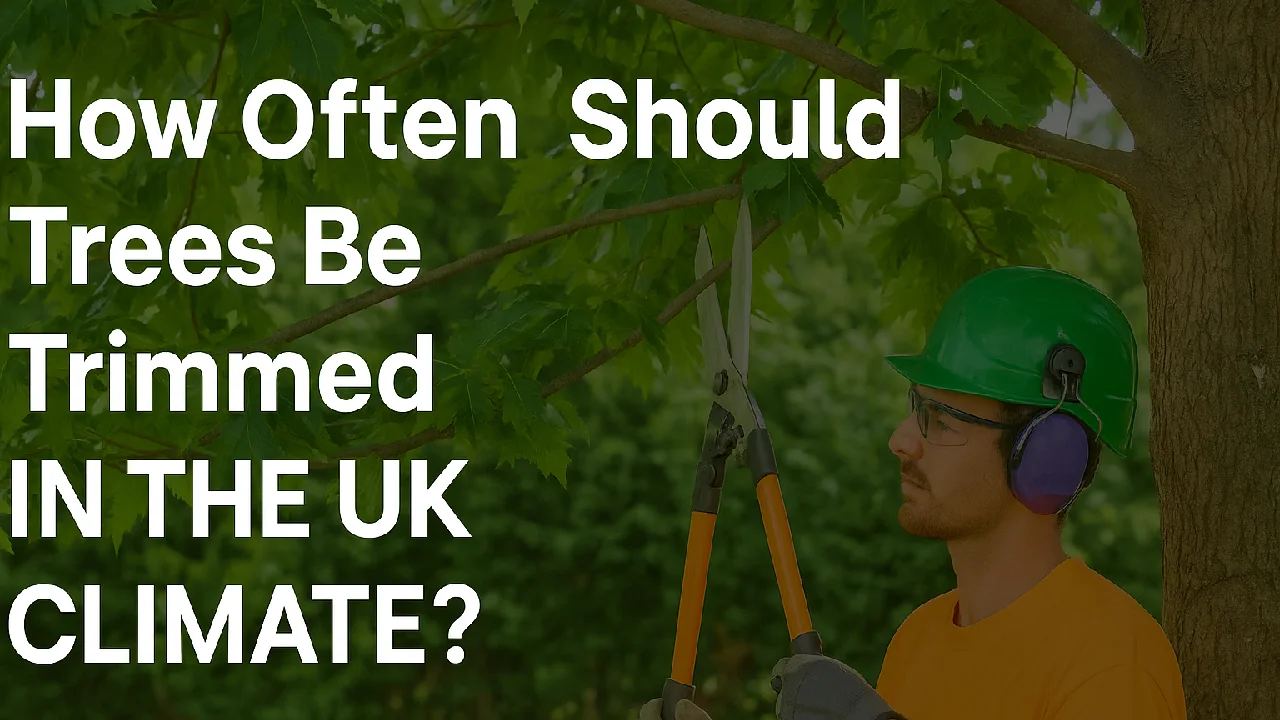Trees are a treasured part of the British landscape whether they’re lining suburban streets, nestled in a quiet back garden, or standing tall in rural fields. But while they’re often admired for their beauty and permanence, trees aren’t entirely self-sufficient.
Just like lawns need mowing and hedges need shaping, trees need regular trimming to stay healthy, safe, and looking their best.
One of the most common questions we hear from homeowners, landlords, and even commercial clients is:
How often should trees be trimmed in the UK climate?
In this post, we’ll break down the answer based on species, tree age, local weather conditions, and seasonal timing so you can care for your trees with confidence.
Understanding the UK Climate and Tree Growth
The UK has a temperate maritime climate, meaning:
- Mild summers
- Cool, wet winters
- Plenty of rainfall year-round
- No prolonged dry or freezing periods
While this makes the UK ideal for lush gardens and thriving woodlands, it also encourages steady tree growth especially for fast-growing species like willow, sycamore, and Leylandii.
This consistent growth means regular pruning is essential, not just for aesthetics, but for the tree’s health and structural safety.
Why Tree Trimming Matters
Whether you call it trimming, pruning, or cutting back, the goal is always the same:
To manage the growth of the tree in a way that:
- Encourages healthy structure
- Removes weak, dead, or dangerous branches
- Improves airflow and light penetration
- Prevents hazards to people or property
Proper pruning can also reduce the risk of storm damage, especially in the autumn and winter months, when high winds and saturated soils are more common.
General Tree Trimming Guidelines (UK)
Here’s a simple guide to how often you should trim trees depending on type and age:
| Tree Type | Recommended Trimming Frequency |
|---|---|
| Young, developing trees | Every 1–2 years (formative pruning) |
| Mature garden trees | Every 3–5 years |
| Fast-growing species | Annually or every 2 years |
| Fruit trees | Yearly (late winter or early spring) |
| Conifers & Leylandii | 1–2 times per year (light shaping) |
| Trees near buildings | As needed to maintain safe clearance |
Tree Species and Pruning Frequency
Different tree species respond differently to pruning. For example:
- Oak Trees: Best pruned every 5 years; too frequent cuts can lead to decay.
- Silver Birch: Ideally trimmed every 2–3 years in late summer to avoid bleeding sap.
- Apple & Pear Trees: Benefit from annual trimming in late winter to encourage fruiting.
- Willows: Fast-growing and often need trimming yearly to prevent overextension.
- Maple Trees: Prune during dormancy (late autumn) every 3–5 years.
Understanding your tree’s specific needs is essential. When in doubt, consult a qualified tree surgeon—they’ll identify the species and provide tailored guidance.
Best Time of Year to Trim Trees in the UK
The timing of pruning is just as important as how often you do it. Pruning at the wrong time can stress a tree or leave it vulnerable to disease.
Best Seasons for Tree Trimming:
- Late Winter (Feb–early March): Ideal for most deciduous trees before sap flow begins.
- Mid–Late Summer (July–August): Great for light maintenance or reducing size.
- Autumn (September): For tidying up after summer growth but before heavy winds.
Times to Avoid:
- Spring (March–May): Trees are budding; pruning can shock them.
- Heavy Frost or Rain Periods: Increases risk of infection or slow healing.
Signs Your Tree Might Need Trimming Sooner
You don’t always need to wait for a set schedule. Watch for these visible signs that your tree needs attention:
- Branches are overhanging gutters, paths, or power lines
- Dead or diseased limbs appear
- The tree is unbalanced or leaning
- It’s blocking sunlight in your garden
- After a storm, you notice cracked or hanging limbs
- Leaves are sparse or smaller than usual
If in doubt, book a tree health inspection with a local tree care specialist.
How Tree Trimming Helps in the Long Term
Proper and regular pruning isn’t just about keeping things tidy—it plays a major role in:
- Preventing costly storm damage
- Extending the lifespan of the tree
- Maintaining safe clearance from buildings and roads
- Improving garden aesthetics and light flow
- Complying with council regulations, especially in conservation areas
It’s always cheaper to maintain a healthy tree than to remove a neglected, dangerous one later.
Can You Trim Trees Yourself?
For small garden trees or hedges, DIY trimming is often fine with the right tools and knowledge.
However, for mature trees, those near buildings, or anything involving chainsaws and heights, we highly recommend hiring a qualified, insured tree surgeon.
They have the expertise, tools, and safety training to carry out the work without risk.
Expert Tip: Keep a Tree Maintenance Log
If you manage multiple trees or own a large property, keep a simple tree maintenance record:
- When it was last trimmed
- What work was done
- Who carried it out
- Notes on any disease or damage
This helps you track patterns and spot potential issues before they become costly.
Need Professional Tree Trimming in Brighton?
Whether it’s formative pruning, seasonal maintenance, or storm prep, our experienced team at Brighton Tree Surgeon can help. We’ve trimmed hundreds of trees across Brighton, Hove, and surrounding areas.
We’re NPTC-certified, fully insured, and offer free tree health checks. Call 01273 947354 today or Book a Tree Survey Online to schedule your next trim.

